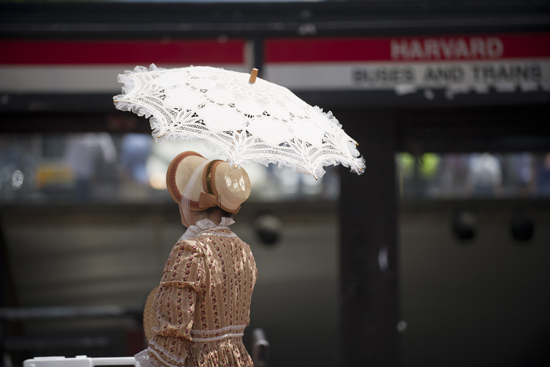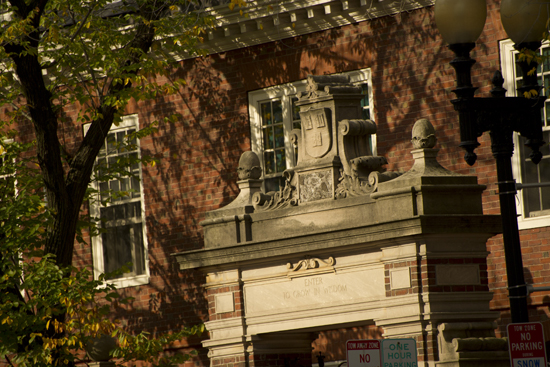Touring Cambridge, in Costume
Alum leads historical tours in Harvard Square
It’s a muggy 80-degree day, and Daniel Berger-Jones stands before a group of tourists dressed in a charcoal wool velvet-trimmed knee-length coat, vest, trousers, and top hat. Tourists passing by do a double take at the 19th-century gentleman holding court in the middle of Harvard Square.
“Did you know,” Berger-Jones (CFA’05) tells a family of five from China, “that Cambridge had the first hippodrome? That there was car racing in Cambridge before most people had seen or driven a car? Francis E. Stanley, a Cambridge resident, would sell steam engine cars, and they actually broke the land speed record in 1906 with a steam engine. It could go all the way up to 127 miles per hour.” The cofounder of Cambridge Historical Tours, Berger-Jones and a team of eight guides lead costumed tours through the brick-lined streets of Harvard Square every day of the week. Boston has the Freedom Trail, Lexington and Concord their battlefields. Cambridge—with one of the oldest and most prestigious universities in the world—has a history that’s just as rich and fascinating.
“If Boston is where this country was born, then Cambridge is where it grew up,” says Berger-Jones, who was a theater arts major at BU and founded his tour company last year with business partner Christopher Schultz. “The tours are exciting, with witty jokes, cheap jokes, and random factoids,” Berger-Jones says. “We aim to educate the biggest history buff as well as the totally restless child who has no desire to be on the tour.”
Berger-Jones plays the role of Richard Henry Dana, Jr., a 19th-century Harvard-educated lawyer. After measles weakened his eyesight, Dana quit school to become a merchant sailor and went on to write Two Years Before the Mast, a now-famous book about the grueling work of a sailor, the beauty of the sea, and the injustices imposed by ship captains. As a lawyer, Dana defended a fugitive slave and the supposed discoverer of ether’s use as an anesthetic, and argued unsuccessful cases of sailors who attempted to sue their captains for abuse.
All of the company’s guides choose their own character from Cambridge history: among them Fanny Appleton Longfellow, Henry Wadsworth Longfellow’s wife, auto enthusiast Francis E. Stanley, and suffragette Margaret Fuller. Visitors get a tour that focuses on that character’s area of expertise—Fuller, for example, will likely highlight factoids on feminist literature, while Frederick Hastings Rindge will talk about his philanthropic efforts.

Playing Dana, Berger-Jones includes a lot of literary trivia, such as stories about the infamous feuds between the Harvard Lampoon and the Harvard Crimson.
Tall and handsome, with a deep voice, Berger-Jones says the idea for Cambridge Historical Tours came about while he and Schultz were working as costumed guides on the Boston Freedom Trail. The duo approached Freedom Trail officials and asked if they were interested in starting a branch in Cambridge. They weren’t, but they offered support as long as the Cambridge endeavor didn’t become a direct competitor.
The next step was to map out the walk, which is two hours long and spans from 1630 through the 20th century.
The tour begins at the Harvard T stop and wanders down to Winthrop Square for some early Cantabrigian history and on to the John Hicks House and the River residences on South Street. From there, it swings past the Harvard Crimson’s house and the National Lampoon and into Harvard Yard, then shoots out through First Parish Church and the Cambridge Burial Ground. Finally, the tour meanders through Tory Row for a look at the Georgian mansions.
Part of the job is to correct misconceptions, such as the conviction that Harvard was founded by John Harvard. “All he did was die young,” Berger-Jones tells his tour group as they stand in front of the Harvard statue in Harvard Yard. “He died at age 31, leaving 800 pounds and 400 books to start a school.”
Regular hazards of the job include tripping over wayward bricks, being heckled by tourists and Harvard Square characters alike, and making oneself heard over buses and the wail of sirens. The job is also weather-dependent, and Berger-Jones relies on his iPhone’s satellite app to tell him when the next storm is rolling in.

In Berger-Jones’ mind, the job requires continuous reading and researching, which has led to some interesting revelations about BU’s campus, too. “There were two very large competing beaches at the turn of the 20th century,” he says. “There was Magazine Beach in Cambridge and the BU Beach, and thousands and thousands of people used to swim in the hepatitis-ridden Charles River. Before the damming of the river in the early 1900s, it was salt water. The water actually went up to today’s BU Beach.”
What exactly makes a tour great? First, says Berger-Jones, the guide must be believably enthusiastic. The more excited the tour guide is, the more excited the tourists. If the group is engaged and asking questions, that’s a great tour.
On today’s outing, signs of boredom are not to be found. Even a 10-year-old boy wants a picture with the John Harvard statue, but wrinkles his nose when Berger-Jones tells him about a long-ago Harvard tradition of students peeing on it.
“Kids will moan and say that history is boring,” says Berger-Jones. “But I say to them that history isn’t boring, your teacher is boring. If you learn it the right way, this is the most fascinating stuff in the world.”
Cambridge Historical Tours offers tours seven days a week on the hour, from 11 a.m. to 4 p.m. Tour times and ticket prices vary. Find more information here.
Comments & Discussion
Boston University moderates comments to facilitate an informed, substantive, civil conversation. Abusive, profane, self-promotional, misleading, incoherent or off-topic comments will be rejected. Moderators are staffed during regular business hours (EST) and can only accept comments written in English. Statistics or facts must include a citation or a link to the citation.